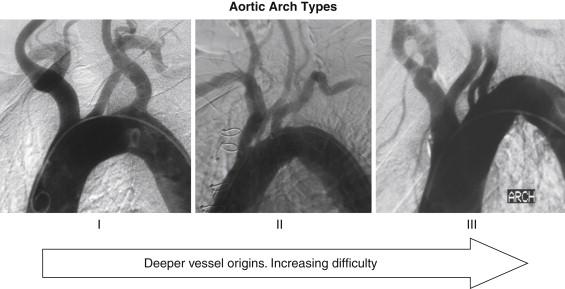Physical Address
304 North Cardinal St.
Dorchester Center, MA 02124
Carotid angioplasty and stenting with cerebral protection has emerged as a minimally invasive alternative to endarterectomy and is a treatment option for carotid arteriosclerotic disease. Carotid angioplasty and stenting comprises the following steps: (1) preprocedural evaluation, (2) femoral access, (3) arch aortogram, (4) selective common carotid catheterization and angiogram, (5) carotid sheath access, (6) crossing of the carotid stenosis, (7) filter placement, (8) predilatation, (9) stenting, (10) postdilatation, (11) completion angiogram, (12) access site management, and (13) postoperative care and follow-up. These technical aspects of carotid angioplasty and stenting are all important.
Before the procedure, an understanding of the arch, carotid, and cerebral arterial anatomy must be obtained by arteriography, computed tomography angiography (CTA) or magnetic resonance angiography (MRA). Anatomic factors may be considered relative contraindications to carotid angioplasty and stenting, including severe arch atherosclerosis or tortuosity, diffuse common carotid artery disease or tortuosity, severe angulation of the bifurcation, or kinking of the distal internal carotid artery (ICA).
Patients should be started on antiplatelet therapy: aspirin daily and clopidogrel (Plavix) 75 mg/day for 5 days before the procedure. Antihypertensive medications are held on the day of the procedure.
The procedure is performed under local anesthesia with minimal or no sedation to facilitate patient cooperation and continuous neurologic monitoring. Continuous arterial pressure monitoring is performed (by transducing the femoral sheath or placing a separate arterial monitoring line), and electrocardiograph (ECG) leads are placed for cardiac monitoring. Acute reduction of blood pressure with pharmacologic agents must be avoided during the intervention, especially because hypotension and bradycardia are not uncommon following stent placement. The patient’s baseline blood pressure should be documented during the prior clinic visit. If antihypertensive therapy is required during the procedure, a short-acting agent should be used.
The common femoral artery is the access site in the vast majority of cases, although carotid angioplasty and stenting has also been performed using brachial, radial, or direct common carotid artery access. A micropuncture set (21-gauge needle) is usually used for the initial femoral access; this has significantly reduced the number of complications from femoral access. Following guidewire access, an introducer sheath is placed in the common femoral artery; the introducer sheath is the same size as that intended for the carotid stent placement, usually 6 or 7 French (Fr). In patients whose femoral pulses are absent as a result of aortoiliac occlusion, a transbrachial approach may be considered. This approach is more challenging compared with the transfemoral approach, and it requires a larger selection of reversed angle catheters. Systemic anticoagulation is typically administered after arterial access but before arch manipulation.
Arch manipulations with guidewires, catheters, and sheaths carry a risk of neurologic events and should be carefully performed. A 260-cm guidewire is placed in the ascending aorta, followed by a pigtail catheter. An initial arch angiogram is performed with the image intensifier in a left anterior oblique (LAO) position. The image intensifier is rotated until the upside-down U shape formed by the guidewire is as wide as possible, usually at least 30 degrees to 45 degrees, to better expose the origins of the arch vessels. The tortuosity of the arch may be assessed by drawing a horizontal line across the apex of the inner curvature of the arch. Vessels that originate below the horizontal line at the apex of the aortic arch often are more difficult to selectively cannulate ( Figure 1 ). Alternatively, the arch may be assessed by less invasive means using CTA or MRA.

Become a Clinical Tree membership for Full access and enjoy Unlimited articles
If you are a member. Log in here